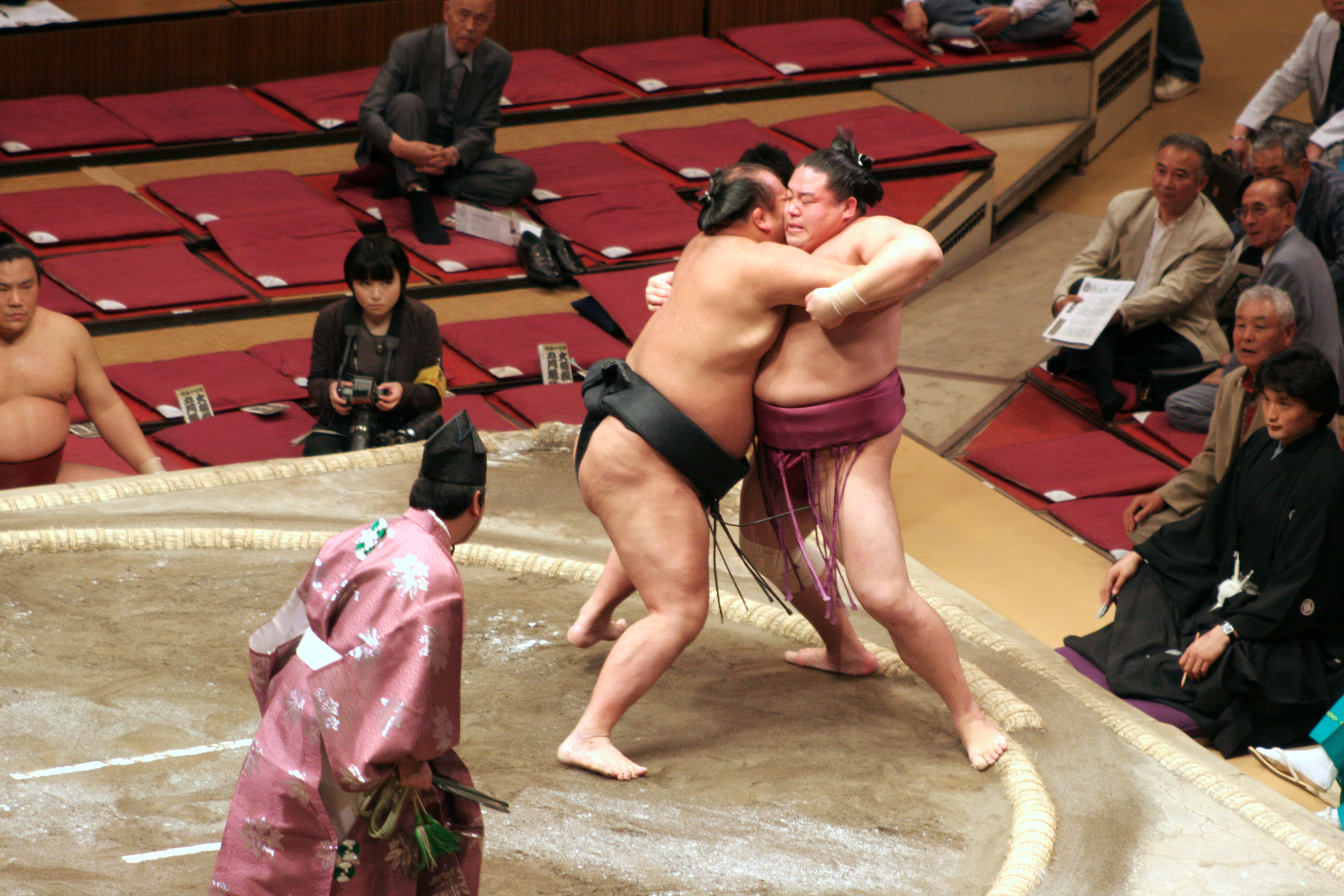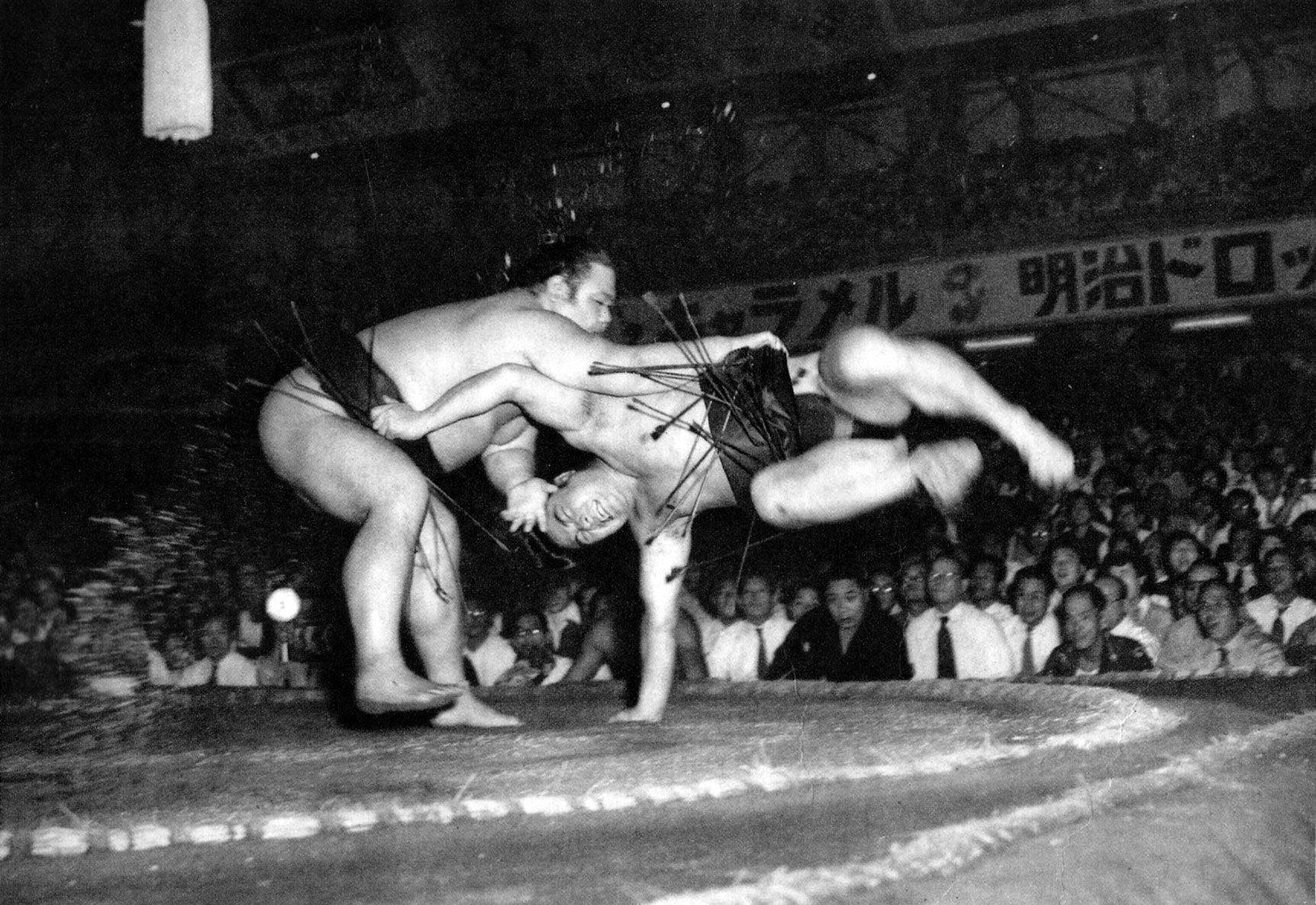|
Hiroshi Wajima
was a Japanese professional sumo wrestler from Nanao, Ishikawa. He was the sport's 54th ''yokozuna'' and is the first wrestler with a collegiate background to reach its highest rank. Entering professional sumo in January 1970, he won a total of 14 tournament championships or ''yūshō'' during his career before retiring in March 1981. He was nicknamed in reference to his trademark gold ''mawashi'' and his preferred technique of a left-handed underarm throw. He was later head coach of Hanakago stable, but after several controversies, Wajima was forced to leave the sumo world and turned to professional wrestling. Sumo career After graduating from Nihon University where he was twice the amateur sumo champion in 1968 and 1969, he made his professional debut in January 1970 at the age of 22, joining Hanakago stable. He was given ''makushita tsukedashi'' status, meaning he could begin in the third highest ''makushita'' division. He was undefeated in his first 14 matches and reached ... [...More Info...] [...Related Items...] OR: [Wikipedia] [Google] [Baidu] |
Shikona
A is a sumo wrestler's ring name. The tradition of ring names in sumo dates back to the Muromachi period and established itself during the Edo period, where they were used as a means to hide the identities of the . Given by the master to his disciple, this pseudonym doesn't follow any fixed rules, but is chosen in accordance with numerous influences, drawing its kanji, characters from the wrestler's inspiration or family, from the history of his stable or even from the master's own name. History Sources attesting to the use of pseudonyms by wrestlers and other martial artists date back to the mid-1500s, during the Muromachi period. During the period of peace established under the Tokugawa shogunate, Japan experienced an unprecedented period of vagrancy for many samurai who had lost their social standing with their previous masters, who had been deposed or killed so that the shogunate could assert itself. These masterless samurai, called , could not engage in any activity under ... [...More Info...] [...Related Items...] OR: [Wikipedia] [Google] [Baidu] |
Makuuchi
, or , is the top division of Professional sumo divisions, the six divisions of professional sumo. Its size is fixed at 42 wrestlers (''rikishi''), ordered into five ranks according to their ability as defined by their performance in previous tournaments. This is the only division that is featured on NHK's standard live coverage of sumo tournaments. The lower divisions are shown on their satellite coverage, with only the ''makuuchi'' broadcast having bilingual English commentary. ''Makuuchi'' literally means "inside the curtain", a reference to the early period of professional sumo, when there was a curtained-off area reserved for the top ranked wrestlers, to sit before appearing for their bouts. Wrestlers are considered for Promotion and relegation, promotion or demotion in rank before each grand tournament according to their performance in the one previous. Generally, a greater number of wins than losses (''kachi-koshi'') results in a promotion, and the reverse (''makekoshi ... [...More Info...] [...Related Items...] OR: [Wikipedia] [Google] [Baidu] |
Tsuridashi
is the technique used in sumo by a (wrestler) to win a match. It is officially decided or announced by the (referee) at the end of the match, though judges can modify this decision. The records of are then kept for statistical purposes. The Japan Sumo Association (JSA) have officially recognized 82 such techniques since 2001, with five also recognized as winning non-techniques. However, only about a dozen of these are frequently and regularly used by . A sumo match can still be won even without a , by the virtue of disqualification due to a (foul), such as striking with closed fist. Basic techniques The are some of the most common winning techniques in sumo, with the exception of . is a rarely used basic that pushes down the opponent into the ground back-first by leaning forward while grappling. is a basic that requires pushing the opponent out of the ring using the arms, without holding their (belt) or extending the arms. is similar to an , exce ... [...More Info...] [...Related Items...] OR: [Wikipedia] [Google] [Baidu] |
Kimarite
is the technique used in sumo by a (wrestler) to win a match. It is officially decided or announced by the (referee) at the end of the match, though judge (sumo), judges can modify this decision. The records of are then kept for statistical purposes. The Japan Sumo Association (JSA) have officially recognized 82 such techniques since 2001, with five also recognized as winning non-techniques. However, only about a dozen of these are frequently and regularly used by . A sumo match can still be won even without a , by the virtue of disqualification due to a (foul), such as striking with closed fist. Basic techniques The are some of the most common winning techniques in sumo, with the exception of . is a rarely used basic that pushes down the opponent into the ground back-first by leaning forward while grappling. is a basic that requires pushing the opponent out of the ring using the arms, without holding their (belt) or extending the arms. is simila ... [...More Info...] [...Related Items...] OR: [Wikipedia] [Google] [Baidu] |
University Of Chicago Press
The University of Chicago Press is the university press of the University of Chicago, a Private university, private research university in Chicago, Illinois. It is the largest and one of the oldest university presses in the United States. It publishes a wide range of academic titles, including ''The Chicago Manual of Style'', numerous academic journals, and advanced monographs in the academic fields. The press is located just south of the Midway Plaisance on the University of Chicago campus. One of its quasi-independent projects is the BiblioVault, a digital repository for scholarly books. History The University of Chicago Press was founded in 1890, making it one of the oldest continuously operating university presses in the United States. Its first published book was Robert F. Harper's ''Assyrian and Babylonian Letters Belonging to the Kouyunjik Collections of the British Museum''. The book sold five copies during its first two years, but by 1900, the University of Chicago Pr ... [...More Info...] [...Related Items...] OR: [Wikipedia] [Google] [Baidu] |
Yakuza
, also known as , are members of transnational organized crime syndicates originating in Japan. The Japanese police and media (by request of the police) call them , while the yakuza call themselves . The English equivalent for the term ''yakuza'' is gangster, meaning an individual involved in a Mafia-like criminal organization. The yakuza are known for their strict codes of conduct, their organized fiefdom nature, and several unconventional ritual practices such as '' yubitsume'', or amputation of the left little finger. Members are often portrayed as males with heavily tattooed bodies and wearing '' fundoshi'', sometimes with a kimono or, in more recent years, a Western-style "sharp" suit covering them. At their height, the yakuza maintained a large presence in the Japanese media, and they also operated internationally. In 1963, the number of yakuza members and quasi-members reached a peak of 184,100. [...More Info...] [...Related Items...] OR: [Wikipedia] [Google] [Baidu] |
Lincoln Continental
The Lincoln Continental is a series of mid-sized and full-sized luxury cars produced between 1939 and 2020 by Lincoln, a division of the American automaker Ford Motor Company. The model line was introduced following the construction of a personal vehicle for Edsel Ford, who commissioned a coachbuilt 1939 Lincoln-Zephyr convertible, developed as a vacation vehicle to attract potential Lincoln buyers. In what would give the model line its name, the exterior was designed with European "continental" styling elements, including a rear-mounted spare tire. In production for over 55 years across nine different decades, Lincoln has produced ten generations of the Continental. Within the Lincoln model line, the Continental has served several roles ranging from its flagship to its base-trim sedan. From 1961 to 1976, Lincoln sold the Continental as its exclusive model line. The model line has also gone on hiatus three times. From 1949 to 1955, the nameplate was briefly retired. In 1 ... [...More Info...] [...Related Items...] OR: [Wikipedia] [Google] [Baidu] |
Perm (hairstyle)
A permanent wave, commonly called a perm or permanent (sometimes called a "curly perm" to distinguish it from a "Hair straightening, straight perm"), is a hairstyle consisting of waves or curls set into the hair. The curls may last a number of months, hence the name. Perms may be applied using thermal or chemical means. In the latter method, chemicals are applied to the hair, which is then wrapped around forms to produce waves and curls. The same process is used for chemical straightening or relaxing, with the hair being flattened instead of curled during the chemical reaction. History The first person to produce a practical thermal method was Marcel Grateau in 1872. He devised a pair of specially manufactured tongs, in which one of the arms had a circular cross-section and the other a concave one, so that one fitted inside the other when the tongs were closed. The tongs were generally heated over a gas or alcohol flame and the correct temperature was achieved by testing the t ... [...More Info...] [...Related Items...] OR: [Wikipedia] [Google] [Baidu] |
The Japan Times
''The Japan Times'' is Japan's largest and oldest English-language daily newspaper. It is published by , a subsidiary of News2u Holdings, Inc. It is headquartered in the in Kioicho, Chiyoda, Tokyo. History ''The Japan Times'' was launched by on 22 March 1897, with the goal of giving Japanese people an opportunity to read and discuss news and current events in English to help Japan participate in the international community. In 1906, Zumoto was asked by Japanese Resident-General of Korea Itō Hirobumi to lead the English-language newspaper '' The Seoul Press''. Zumoto closely tied the operations of the two newspapers, with subscriptions of ''The Seoul Press'' being sold in Japan by ''The Japan Times'', and vice versa for Korea. Both papers wrote critically of Korean culture and civilization, and advocated for Japan's colonial control over the peninsula in order to civilize the Koreans. The newspaper was independent of government control, but from 1931 onward, the pa ... [...More Info...] [...Related Items...] OR: [Wikipedia] [Google] [Baidu] |
Kanji
are logographic Chinese characters, adapted from Chinese family of scripts, Chinese script, used in the writing of Japanese language, Japanese. They were made a major part of the Japanese writing system during the time of Old Japanese and are still used, along with the subsequently-derived Syllabary, syllabic scripts of and . The characters have Japanese pronunciations; most have two, with one based on the Chinese sound. A few characters were invented in Japan by constructing character components derived from other Chinese characters. After the Meiji Restoration, Japan made its own efforts to simplify the characters, now known as , by a process similar to China's simplified Chinese characters, simplification efforts, with the intention to increase literacy among the general public. Since the 1920s, the Japanese government has published character lists periodically to help direct the education of its citizenry through the myriad Chinese characters that exist. There are nearly 3 ... [...More Info...] [...Related Items...] OR: [Wikipedia] [Google] [Baidu] |







